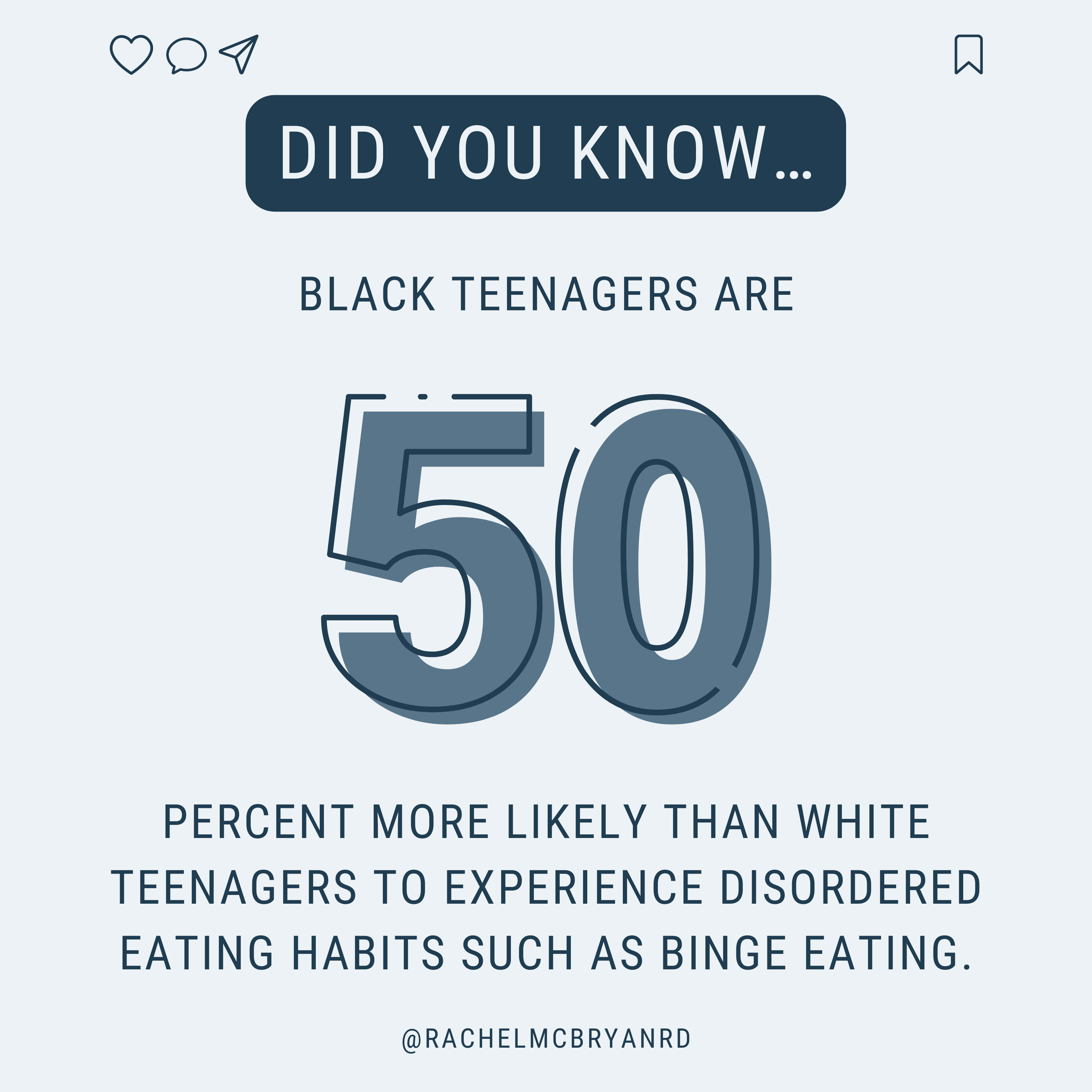As I mentioned in an earlier article, eating disorders can affect anyone. They don’t discriminate against age, gender, socioeconomic status or even your genetic predisposition to being slim. However, we are being to find that there are higher rates of eating disorders in BIPOC and other marginalized communities.
Statistics show that black teenagers are 50% more likely than white teenagers to have disordered eating behaviours such as binging. Some studies have also predicted an increase in the rates of eating disorders in marginalized communities.
There are a few reasons why these communities experience a higher rate of eating disorders including social body standards, historical appreciation and values of bodies. The combination of these factors along with genetics, internal beliefs, and social environment leads to higher rates of eating disorders in marginalized communities.

Diagnosis of Eating Disorders in the BIPOC Community
Although BIPOC communities experience higher rates of eating disorders, members of these communities are less likely to be diagnosed than non-marginalized communities. This stems from many factors including systemic racism, fatphobia and the high financial cost of eating disorder specialists.
Systemic Racism
Racism is a significant barrier for BIPOC community. Both systemic racism within the healthcare system, as well as racism directed towards individuals can negatively impact their health. It can impact a person’s ability to gain access to the health resources they need.
Fatphobia
Despite many of the changes we are seeing in the advertisements and on the runways, fatphobia continues to be prominent throughout both our society, as well as our healthcare system. In many circumstances, doctors and other healthcare professionals may make assumptions about an individual’s health and lifestyle based only on their weight. Some people have experienced doctors focusing on their weight rather than their health concern. As a result people living in larger bodies may be hesitant to go to their doctor for help. .
Financial Cost
The financial cost is another barrier that contributes to the low diagnostic rates amongst BIPOC communities. In many situations, eating disorder specialists come at a high cost, and may not be covered by health insurance. Similar to other circumstances, the financial cost of addressing eating disorders disproportionally affects members of BIPOC and other marginalized communities.

Seeking Help
Deciding to seek help for your eating disorder can be a big and overwhelming step for anyone to take. The additional changes and barriers can make this step even more overwhelming and challenging for members of the BIPOC community. This can contribute to the low rates of diagnosis and treatment within BIPOC and marginalized communities.
How Do Eating Disorders Affect the BIPOC Community?
Although eating disorders can affect anyone, and everyone, most research into eating disorders has been conducted in the white community. This has led to a gap in knowledge of underlying causes and complications of eating disorders in the BIPOC community.
Ultimately, more inclusive research is needed to provide insight into eating disorders in BIPOC community, as well as in other marginalized communities, and develop effective approaches for the identification and treatment of these eating disorders.
More Resources
Although there are a limited number of resources a available, you can find resources for eating disorders within marginalized communities at:
Address Your Eating Disorder with Confidence
Working with a registered dietitian can help you address your eating disorder and rebuild your confidence and relationship with food. Book a FREE discovery call to learn how a Registered Dietitian can help.
References
Bray, B., Bray, C., Bradley, R., & Zwickey, H. (2022). Binge Eating Disorder Is a Social Justice Issue: A Cross-Sectional Mixed-Methods Study of Binge Eating Disorder Experts’ Opinions. International Journal of Environmental Research and Public Health, 19(10), 6243. https://doi.org/10.3390/ijerph19106243
Goeree, M. S., Ham, J. C., & Iorio, D. (2011). Race, Social Class, and Bulimia Nervosa. 5823. http://ftp.iza.org/dp5823.pdf.
Gordon, K. H., Brattole, M. M., Wingate, L. R. R., & Joiner, T. E. (2006). The Impact of Client Race on Clinician Detection of Eating Disorders. Behavior Therapy, 37(4), 319–325. https://doi.org/10.1016/J.BETH.2005.12.002
Hooper, L., Puhl, R., Eisenberg, M. E., Crow, S., & Neumark-Sztainer, D. (2021). Weight teasing experienced during adolescence and young adulthood: Cross-sectional and longitudinal associations with disordered eating behaviors in an ethnically/racially and socioeconomically diverse sample. International Journal of Eating Disorders, 54(8), 1449–1462. https://doi.org/10.1002/EAT.23534
Katzmarzyk, P. T., Bray, G. A., Greenway, F. L., Johnson, W. D., Newton, R. L., Ravussin, E., Ryan, D. H., & Bouchard, C. (2011). Ethnic-Specific BMI and waist circumference thresholds. Obesity, 19(6), 1272–1278. https://doi.org/10.1038/OBY.2010.319
Mikhail, M. E., & Klump, K. L. (2021). A virtual issue highlighting eating disorders in people of black/African and Indigenous heritage. International Journal of Eating Disorders, 54(3), 459–467. https://doi.org/10.1002/EAT.23402
Muhlheim, L. (2022, May 9). The Impact of Race and Racism on Eating Disorders. Very Well Mind. https://www.verywellmind.com/race-racism-and-eating-disorders-5076344
Robinson, R. (2020, July 21). Why bipoc with eating disorders are often overlooked. aSweatLife. https://asweatlife.com/2020/07/bipoc-eating-disorder-treatment/
Sim, L. (2019). Our Eating Disorders Blind Spot: Sex and Ethnic/Racial Disparities in Help-Seeking for Eating Disorders. Mayo Clinic Proceedings, 94(8), 1398–1400. https://doi.org/10.1016/J.MAYOCP.2019.06.006
Underwood, E. (2021). Eating Disorders: Information and Support Resources. Journal of Consumer Health on the Internet, 25(4), 433–442. https://doi.org/10.1080/15398285.2021.1988294
With a Bachelor of Science in Nutrition and Food Science, Rachel has over 15 years’ experience helping people address their health through nutrition.


